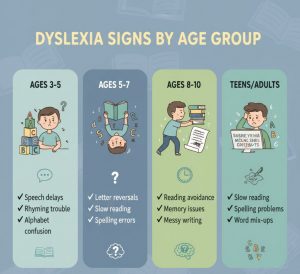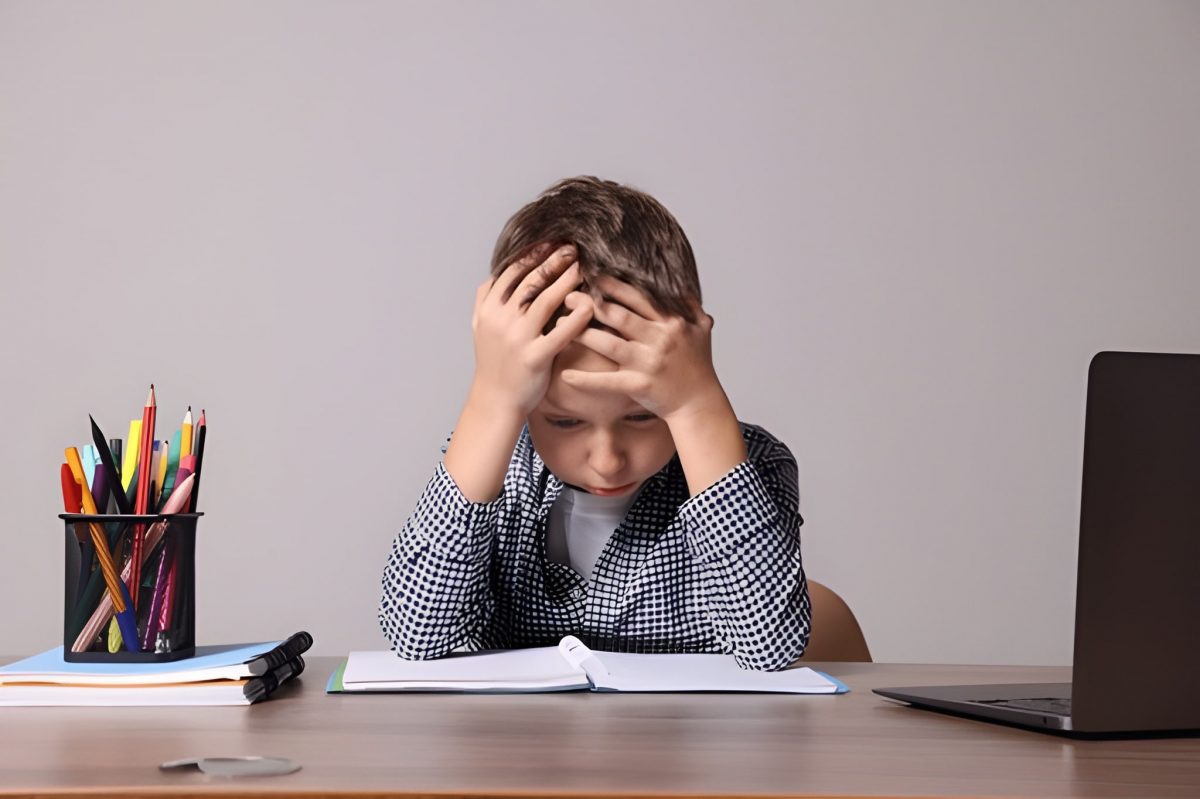Dyslexia Signs in Children: A Parent’s Guide to Early Detection
Dyslexia Signs in Children: Spot Them Early
Dyslexia signs in children can be hard to spot but recognizing them early changes everything. Have you noticed your bright child struggling to read simple words? Does homework time feel like a battle? If so, you’re not alone
Recognizing dyslexia signs in children early can change everything. In fact, early help makes a huge difference in your child’s future success. Moreover, understanding these signs is the first step to getting the right support.

This guide will help you spot dyslexia signs in children at every age. Plus, you’ll learn exactly what to do next.
Dyslexia signs in children can be hard to spot but recognizing them early changes everything. Have you noticed your bright child struggling to read simple words? Does homework time feel like a battle? If so, you’re not alone
Recognizing dyslexia signs in children early can change everything. In fact, early help makes a huge difference in your child’s future success. Moreover, understanding these signs is the first step to getting the right support.
This guide will help you spot dyslexia signs in children at every age. Plus, you’ll learn exactly what to do next.
What Are Dyslexia Signs in Children? (Simple Explanation)
First, let’s clear up a common myth. Dyslexia is NOT a sign of low intelligence. Instead, it’s simply a learning difference that affects how the brain reads words.
Here’s what dyslexia really means:
- The brain processes letters and sounds differently
- Reading and spelling become harder than expected
- However, intelligence stays completely normal (or above average!)
- It’s very common affecting 1 in 5 children
According to the International Dyslexia Association, dyslexia is a brain-based condition. Therefore, it’s not about lack of effort or practice. Rather, it’s about how the brain is wired.
Key Point: Your child isn’t lazy or unintelligent. Instead, their brain just learns to read in a different way.
Early Dyslexia Signs in Children: Preschool Years (Ages 3-5)

Catching signs early really matters. In fact, early help leads to better outcomes. So, watch for patterns over time, not just one-time issues.
Speech and Language Dyslexia Signs in Children
First, pay attention to how your child talks. Here are some early warning signs:
Delayed Speech
- Your child speaks later than other kids
- Additionally, they use fewer words than expected for their age
- Furthermore, simple words feel hard for them
Baby Talk That Won’t Go Away
- For example, saying “beddy tear” instead of “teddy bear”
- Or saying “aminal” instead of “animal”
- Moreover, this continues past age 4 or 5
Trouble Finding the Right Words
- Your child often says “that thing” or “you know”
- Similarly, they point instead of naming objects
- Plus, they struggle to remember familiar words
Sound and Letter Problems: Common Dyslexia Signs in Children
Next, watch how your child works with sounds. This is called phonological awareness. It’s super important for reading.
Alphabet Troubles
- First, they can’t remember the ABC song
- Also, they don’t recognize letters in their name
- Furthermore, learning letter sounds takes much longer
Rhyming Is Really Hard
- For instance, they can’t tell that “cat” and “hat” rhyme
- Moreover, rhyming games feel impossible
- As a result, nursery rhymes confuse them
Can’t Break Words Into Sounds
- They can’t tell you the first sound in “ball”
- Similarly, clapping out syllables doesn’t make sense
- Plus, blending sounds together feels impossible
Remember: One or two signs don’t mean dyslexia. However, multiple signs together over time are worth watching.
Dyslexia Signs in Children During Elementary School (Ages 5-10)

When school starts, reading becomes more important. As a result, dyslexia signs become clearer. This can be frustrating for everyone.
Kindergarten to 2nd Grade: Key Dyslexia Signs in Children (Ages 5-7)
During these early years, watch for these signs:
Letter and Sound Confusion
- First, your child can’t connect letters to sounds
- For example, they don’t know that “B” makes the /b/ sound
- Moreover, this doesn’t improve with practice
Mix-Ups With Similar Letters
- They constantly confuse b and d
- Similarly, p and q get mixed up
- Plus, words like “was” and “saw” look the same to them
- Furthermore, this continues past age 6
Reading Feels Impossible
- Sounding out simple words takes forever
- For instance, “cat” feels as hard as a big word
- Additionally, they guess words based on the first letter
- As a result, reading feels like a constant struggle
Spelling Is All Over the Place
- The same word gets spelled differently each time
- Moreover, even simple words come out wrong
- Plus, spelling doesn’t match what they just read
Avoids Reading
- Your child complains that reading is too hard
- Similarly, they make excuses to skip reading time
- Furthermore, reading aloud causes real anxiety
3rd to 5th Grade: Advanced Dyslexia Signs in Children (Ages 8-10)
In these grades, kids shift from learning to read to reading to learn. Therefore, new challenges appear:
Very Slow Reading
- Reading takes tons of mental energy
- Moreover, they read much slower than classmates
- As a result, finishing assignments takes hours
Won’t Read Out Loud
- They panic when called on to read
- Similarly, they’ll do anything to avoid it
- Plus, embarrassment becomes a real problem
Memory Problems
- They can’t remember the months in order
- For instance, their phone number is hard to recall
- Additionally, multiplication tables won’t stick
Messy Writing
- Spelling errors are everywhere
- Moreover, even common words come out wrong
- Furthermore, their writing lacks organization
- Plus, punctuation seems random
Literal Thinking
- Jokes go over their head
- For example, “raining cats and dogs” sounds real to them
- Similarly, expressions don’t make sense
Action Step: If you see multiple signs, start keeping notes. Then, talk to your child’s teacher or doctor about testing.

Dyslexia Signs in Children: Teen and Adult Years
Here’s an important fact: dyslexia doesn’t go away with age. However, it does change over time. Many people develop ways to hide their struggles.
Reading and Writing Challenges
First, these core problems often continue:
Reading Takes Real Effort
- Getting through textbooks feels exhausting
- Moreover, long emails are mentally draining
- As a result, they avoid reading when possible
Spelling Stays Unpredictable
- Spell-check helps, but errors still happen
- For example, “there” and “their” get mixed up
- Similarly, “form” and “from” cause confusion
Writing Causes Stress
- They put off emails and reports
- Additionally, they find excuses not to write
- Furthermore, they prefer phone calls to texts
Summarizing Is Hard
- After reading something, they can’t explain it
- Moreover, remembering the main points feels impossible
- Plus, taking notes in class or meetings is really tough
Memory and Organization Issues
Next, daily life gets affected too:
Numbers and Dates Won’t Stick
- PINs and passwords are always forgotten
- Similarly, important dates slip their mind
- Plus, phone numbers need to be written down
Time Management Problems
- They always underestimate how long tasks take
- As a result, deadlines get missed
- Furthermore, they feel constantly rushed
Word Mix-Ups
- Long words come out jumbled
- Moreover, names are hard to pronounce
- Plus, common phrases get scrambled
Emotional Dyslexia Signs in Children: The Hidden Impact
Beyond academics, dyslexia affects feelings too. In fact, this emotional impact is often overlooked. However, it’s just as important to recognize.
Low Confidence and Frustration
First, the constant struggle takes a toll:
Feeling “Unintelligent“
- Despite being smart, they feel less capable
- Moreover, comparing themselves to others hurts
- As a result, self-esteem drops over time
Intense Frustration
- Daily struggles lead to anger outbursts
- Additionally, others might think it’s bad behavior
- However, it’s really about feeling overwhelmed
Anxiety and Avoidance
Next, fear starts controlling choices:
School Anxiety
- Fear of being called on creates constant stress
- Similarly, test anxiety becomes severe
- Plus, Sunday nights feel especially hard
Active Avoidance
- Some kids refuse to go to school
- Moreover, adults turn down promotions to avoid more writing
- Furthermore, social situations involving reading get skipped
Unfair Labels
- Others call them “lazy” or “not trying”
- However, they’re actually working twice as hard
- As a result, shame and isolation grow
Important: If your child shows anxiety or depression alongside dyslexia signs, get help from a mental health professional right away.
The Amazing Strengths Behind Dyslexia Signs in Children
Now for some good news! Dyslexia comes with real strengths. In fact, many successful people have dyslexia. Moreover, the dyslexic brain thinks differently and that’s powerful.
Creative and Big-Picture Thinking
First, people with dyslexia often see solutions others miss:
- They excel at creative problem-solving
- Moreover, they connect ideas in new ways
- Plus, they make excellent entrepreneurs and designers
Strong Visual and Spatial Skills
Next, many have exceptional 3D thinking:
- They visualize complex systems easily
- Additionally, they excel in engineering and architecture
- Furthermore, art and design come naturally
Curiosity and Innovation
Finally, they approach problems differently:
- They think outside the box naturally
- Moreover, their curiosity drives deep learning
- As a result, they often find unique solutions
What to Do Next: Your Action Plan
If you’ve recognized dyslexia signs in your child, don’t panic. Instead, follow these clear steps. Moreover, remember that early action makes a huge difference.
Step 1: Keep a Simple Record
First, start documenting what you notice:
- Write down specific reading or spelling problems
- Additionally, note when frustration happens
- Moreover, compare to siblings or classmates
- Plus, record any family history of learning differences
Why this helps: Professionals need specific examples. Therefore, your notes become valuable evidence.
Step 2: Get Professional Testing
Next, seek a formal evaluation. This is the only way to confirm dyslexia. Moreover, qualified professionals conduct these tests.
Who can test:
- School psychologists
- Educational psychologists
- Neuropsychologists
First steps:
- Talk to your child’s teacher
- Then, contact your school administrator
- Or, ask your family doctor for a referral
What testing includes:
- Reading skill assessments
- Cognitive ability tests
- Language processing evaluation
- Plus, a complete learning profile
Step 3: Find Support and Resources
Finally, connect with helpful organizations:
International Dyslexia Association (IDA)
- The leading scientific organization on dyslexia
- Moreover, they offer evidence-based information
- Plus, they can help you find local resources
Understood.org
- Award-winning resource for learning differences
- Additionally, they provide practical tools for parents
- Furthermore, they have an active support community
Yale Center for Dyslexia & Creativity
- Premier research center
- Moreover, they explain the science clearly
- Plus, they highlight dyslexia strengths
How This Connects to Your Child’s Growth
Understanding dyslexia signs in children is part of supporting their whole development. Moreover, these related topics might help:
Why Your Baby Cries for No Reason: Understanding Your Newborn’s Needs Understanding your child’s communication from birth helps you notice when something feels different later.
Get Your Baby to Sleep: 5 Proven Tricks Good sleep improves learning. In fact, well-rested kids handle challenges better.
Creating a Safe, Healthy Environment for Your Newborn A supportive home helps all areas of development, including learning.
Common Questions About Dyslexia Signs in Children
Can dyslexia be outgrown?
No, dyslexia is lifelong. However, proper support helps tremendously. Moreover, many people with dyslexia succeed in school and careers. In fact, early help makes the biggest difference.
Is dyslexia the same as ADHD?
No, these are different conditions. However, they can happen together. Dyslexia affects language processing. Meanwhile, ADHD affects attention and impulse control. Therefore, professional testing helps tell them apart.
How common is dyslexia?
Dyslexia affects about 1 in 5 children. This makes it very common. Moreover, many successful people have dyslexia. In fact, it’s nothing to be ashamed of.
Can I tell if my child has dyslexia just by watching them read?
You can notice warning signs. However, only professional testing confirms dyslexia. Therefore, your observations are valuable, but formal evaluation is necessary.
My child reads well but can’t spell. Could this be dyslexia?
Yes, absolutely. Dyslexia looks different in different people. Moreover, some kids develop strong reading through hard work. However, spelling and writing might still be hard. Therefore, testing can clarify this.
What’s the difference between dyslexia and just being a slow reader?
All kids learn at different speeds. However, dyslexia involves specific, ongoing problems. Moreover, these problems are unexpected given the child’s intelligence. Furthermore, regular teaching alone doesn’t fix them. Therefore, professional evaluation helps determine the difference.
Will my child need special education?
It depends on individual needs. Some children do well with extra help in regular classrooms. However, others benefit from special education services. Therefore, a school evaluation determines the best plan.
Final Thoughts
Recognizing dyslexia signs in children opens doors to the right support. Moreover, early action leads to better outcomes. Remember, dyslexia doesn’t define your child’s intelligence or potential.
Take action today:
- First, review the signs in this guide
- Next, start keeping notes on what you observe
- Then, talk to your child’s teacher or doctor
- Finally, pursue professional evaluation if needed
Your child’s journey is unique. However, with the right support, they can absolutely thrive. Moreover, many successful people have dyslexia and your child can join them.
What signs have you noticed in your child? Share your experience in the comments below. Your story might help another worried parent.



